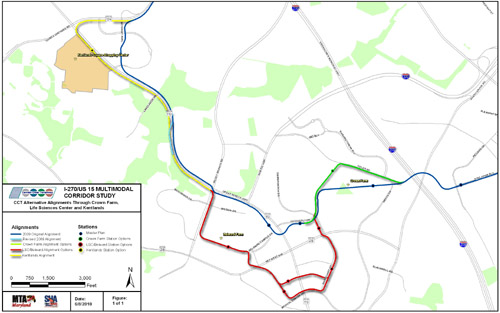MTA considers a better Corridor Cities Transitway
Three potential alignment changes for the Corridor Cities Transitway, a proposed light rail or BRT line running north from Shady Grove Metro through Gaithersburg, will let the line reach the walkable neighborhoods near its route and substantially increase ridership at relatively little cost.
In 2006, planners ignored the many walkable, urban neighborhoods near the route and instead opting to locate stations near large parking lots. Around the same time, Montgomery County’s Action Committee For Transit proposed a U-shaped realignment that would have solved those problems, but would have required a fairly dramatic re-planning effort.
To their credit, MTA heard the criticism and responded. They are now strongly considering a series of three realignments that would dramatically improve access to walkable destinations and increase expected ridership on the line.
The first two realignments, those shown in green and yellow, would more directly serve dense, walkable, mixed-use developments. The green one would move to run through the center and densest part of Crown Farm, a massive TOD-to-be. The yellow alignment would provide a station at Kentlands, the famous New Urbanist development.
The red alignment will more directly serve the so-called Science City. Although that won’t be a particularly walkable destination, it is dense with jobs and will provide a significant boost in expected ridership.
All together, these three changes are expected to increase ridership from somewhere between 21,000-30,000 daily (depending on mode and other factors) to between 29,000-42,000 daily, at a cost of about $100 million on top of the estimates for the original alignment. That’s such a phenomenally good deal that it would set the Corridor Cities Transitway as one of the most cost-effective projects in the pipeline in the entire country, therefore positioning it excellently to receive federal funds.
MTA should adopt all three realignments. Each one improves transit access to important destinations over the original route, and each improves Maryland’s chances of receiving federal funds.


